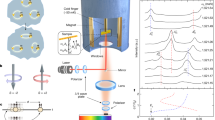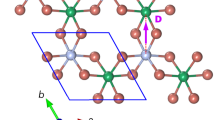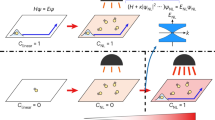Abstract
Bose–Einstein condensation1,2 is one of the most fascinating phenomena predicted by quantum mechanics. It involves the formation of a collective quantum state composed of identical particles with integer angular momentum (bosons), if the particle density exceeds a critical value. To achieve Bose–Einstein condensation, one can either decrease the temperature or increase the density of bosons. It has been predicted3,4 that a quasi-equilibrium system of bosons could undergo Bose–Einstein condensation even at relatively high temperatures, if the flow rate of energy pumped into the system exceeds a critical value. Here we report the observation of Bose–Einstein condensation in a gas of magnons at room temperature. Magnons are the quanta of magnetic excitations in a magnetically ordered ensemble of magnetic moments. In thermal equilibrium, they can be described by Bose–Einstein statistics with zero chemical potential and a temperature-dependent density. In the experiments presented here, we show that by using a technique of microwave pumping it is possible to excite additional magnons and to create a gas of quasi-equilibrium magnons with a non-zero chemical potential. With increasing pumping intensity, the chemical potential reaches the energy of the lowest magnon state, and a Bose condensate of magnons is formed.
This is a preview of subscription content, access via your institution
Access options
Subscribe to this journal
Receive 51 print issues and online access
$199.00 per year
only $3.90 per issue
Buy this article
- Purchase on Springer Link
- Instant access to full article PDF
Prices may be subject to local taxes which are calculated during checkout




Similar content being viewed by others
References
Bose, S. N. Plancks Gesetz und Lichtquantenhypothese. Z. Phys. 26, 178–181 (1924)
Einstein, A. Quantentheorie des einatomigen idealen Gases. Part I. Sber. Preuss. Akad. Wiss. 22, 261–267 (1924); Quantentheorie des einatomigen idealen Gases. Part II. Sber. Preuss. Akad. Wiss. 1, 3–14 (1925)
Fröhlich, H. Bose condensation of strongly excited longitudinal electric modes. Phys. Lett. A 26, 402–403 (1968)
Mesquita, M. V., Vasconcellos, A. R. & Luzzi, R. Positive-feedback-enhanced Fröhlich's Bose–Einstein-like condensation in biosystems. Int. J. Quant. Chem. 66, 177–187 (1998)
Anderson, M. H., Ensher, J. R., Matthews, M. R., Wieman, C. E. & Cornell, E. A. Observation of Bose–Einstein condensation in a dilute atomic vapor. Science 269, 198–201 (1995)
Davis, K. B. et al. Bose–Einstein condensation in a gas of sodium atoms. Phys. Rev. Lett. 75, 3969–3973 (1995)
Bloch, I., Hänsch, T. W. & Esslinger, T. Measurement of the spatial coherence of a trapped Bose gas at the phase transition. Nature 403, 166–170 (2000)
Hancox, C. I., Doret, S. C., Hummon, M. T., Luo, L. J. & Doyle, J. M. Magnetic trapping of rare-earth atoms at millikelvin temperatures. Nature 431, 281–284 (2004)
Keldysh, L. V. The electron-hole liquid in semiconductors. Contemp. Phys. 27, 395–428 (1986)
Butov, L. V. Condensation and pattern formation in cold exciton gases in coupled quantum wells. J. Phys. Condens. Matter 16, R1577–R1613 (2004)
Fukuzawa, T., Mendez, E. E. & Hong, J. M. Phase transition of an exciton system in GaAs coupled quantum wells. Phys. Rev. Lett. 64, 3066–3069 (1990)
Eisenstein, J. P. & MacDonald, A. M. Bose–Einstein condensation of excitons in bilayer electron systems. Nature 432, 691–694 (2004)
Yamamoto, Y. Half-matter, half-light amplifier. Nature 405, 629–630 (2000)
Misochko, O. V., Hase, M., Ishioka, K. & Kitajima, M. Transient Bose–Einstein condensation of phonons. Phys. Lett. A 321, 381–387 (2004)
Kalafati, Y. D. & Safonov, V. L. Thermodynamic approach to the theory of paramagnetic resonance of magnons. Zh. Eksp. Teor. Phys. 95, 2009–2020 (1989); [in English] Sov. Phys. JETP 68, 1162 (1989)
Kaganov, M. I., Pustylnik, N. B. & Shalaeva, T. I. Magnons, magnetic polaritons, magnetostatic waves. Phys. Usp. 40, 181–224 (1997)
Nikuni, T., Oshikawa, M., Oosawa, A. & Tanaka, H. Bose–Einstein condensation of dilute magnons in TlCuCl3 . Phys. Rev. Lett. 84, 5868–5871 (2000)
Rüegg, C. et al. Bose–Einstein condensation of the triplet states in the magnetic insulator TlCuCl3 . Nature 423, 62–65 (2003)
Della Torre, E., Bennett, L. H. & Watson, R. E. Extension of the Bloch T3/2 law to magnetic nanostructures: Bose–Einstein condensation. Phys. Rev. Lett. 94, 147210 (2005)
L'vov, V. S. Wave Turbulence Under Parametric Excitation (Springer, Berlin, 1994)
Gurevich, A. G. & Melkov, G. A. Magnetization Oscillations and Waves (CRC, New York, 1996)
Demokritov, S. O., Hillebrands, B. & Slavin, A. N. Brillouin light scattering studies of confined spin waves: linear and nonlinear confinement. Phys. Rep. 348, 441–489 (2001)
Damon, R. W. & Eshbach, J. R. Magnetostatic modes of a ferromagnet slab. J. Phys. Chem. Solids 19, 308–320 (1961)
Sparks, M. Ferromagnetic resonance in thin films. I. Theory of normal-mode frequencies. Phys. Rev. B 1, 3831–3856 (1970)
Wolfram, T. & De Wames, R. E. Magnetoexchange branches and spin-wave resonance in conducting and insulating films: perpendicular resonance. Phys. Rev. B 4, 3125–3141 (1971)
Cottam, M. & Lockwood, D. Light Scattering in Magnetic Solids (Wiley, New York, 1986)
Acknowledgements
Support by the Deutsche Forschungsgemeinschaft, the US Army Research Office, and the Science & Technology Center of Ukraine is acknowledged. We are also indebted to D. Mills, V. Safonov and M. Katsnelson for discussions.
Author information
Authors and Affiliations
Corresponding author
Ethics declarations
Competing interests
Reprints and permissions information is available at www.nature.com/reprints. The authors declare no competing financial interests.
Rights and permissions
About this article
Cite this article
Demokritov, S., Demidov, V., Dzyapko, O. et al. Bose–Einstein condensation of quasi-equilibrium magnons at room temperature under pumping. Nature 443, 430–433 (2006). https://doi.org/10.1038/nature05117
Received:
Accepted:
Issue Date:
DOI: https://doi.org/10.1038/nature05117
This article is cited by
-
Persistent magnetic coherence in magnets
Nature Materials (2024)
-
Field-induced bound-state condensation and spin-nematic phase in SrCu2(BO3)2 revealed by neutron scattering up to 25.9 T
Nature Communications (2024)
-
Electrical detection of spin pumping in van der Waals ferromagnetic Cr2Ge2Te6 with low magnetic damping
Nature Communications (2023)
-
Double dome structure of the Bose–Einstein condensation in diluted S = 3/2 quantum magnets
Nature Communications (2023)
-
Reversal of nanomagnets by propagating magnons in ferrimagnetic yttrium iron garnet enabling nonvolatile magnon memory
Nature Communications (2023)
Comments
By submitting a comment you agree to abide by our Terms and Community Guidelines. If you find something abusive or that does not comply with our terms or guidelines please flag it as inappropriate.



